April 7, 2010
![]()
With anticipation running high, with the world waiting, this Thursday promises to bring the announcement of what I am hearing are three skeletons found in South Africa of a new hominin species, what was earlier called by the media, a “missing link.” (Of course, all links are missing until they are found.)
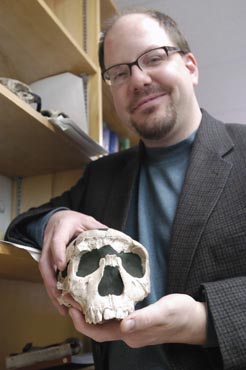
University of Wisconsin-Madison anthropologist John Hawks. Photo by: Michael Forster Rothbart. (Interestingly, just last week, two UW anthropology students, on spring break, drove straight out from Madison to Portland, Maine, to visit me at the museum.)
I look forward to reading what Hawks’ open-minded and insightful weblog and others will have to say on the new finds.
In the meantime, new graphics are being produced related to this forthcoming find, as well as that of the X-Woman or the so-called Denisova “fourth human,” and older discoveries.
For example, good images have surfaced of a new exhibition of some of the 27 replica heads of extinct hominids on display at the Senckenberg Natural History Museum in Frankfurt, Germany. Images of the replicas are below.
Let’s take a peek.
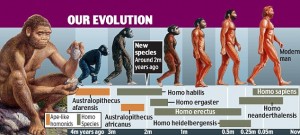
New chart notes the location in the chronology for the “missing link.” Larger image at bottom. Credit: The Daily Mail.
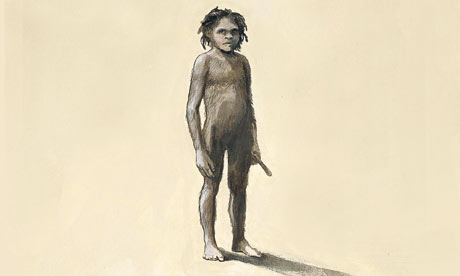
Josie Jammet’s illustration for The Guardian of the X-Woman or Denisova hominin seems to depict a male, as did the early drawings of the female Homo floresiensis. But maybe not?
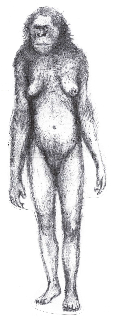
Richard Klyver’s illustration of Homo floresiensis, depicted the hobbit LB1 in the correct gender.
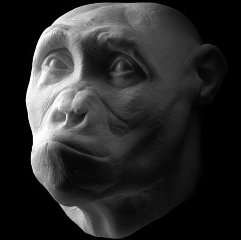
Sahelanthropus tchadensis, living 6.8million years ago, parts of its jaw bone and teeth were found nine years ago in the Djurab desert, Chad, and from this scientists created this model head.
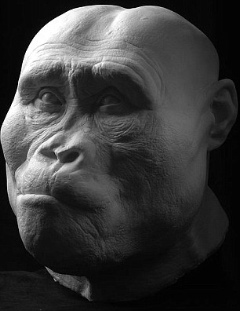
This skull was fashioned from a skull and jaw found in the remains of 17 pre-humans (nine adults, three youths and five children) which were discovered in the Afar Region of Ethiopia in 1975. They are believed to have lived 3.2million years ago.
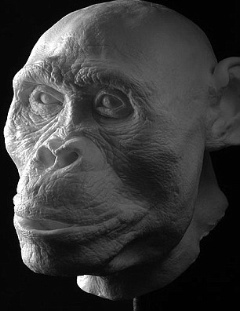
“Mrs. Ples” was unearthed in Sterkfontein, South Africa in 1947. Her complete skull was found and it is believed she lived 2.5 million years ago. Sediment traces found on the inside of her skull indicate to scientists that she died by falling into a chalk pit.
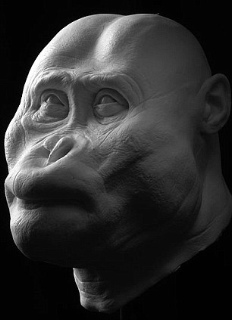
The skull of this male adult was found on the western shore of Lake Turkana in Kenya in 1985. He is believed to have lived in 2.5 million years ago. The shape of the mouth indicates that he had a strong bite and that he could chew sinewy plants.
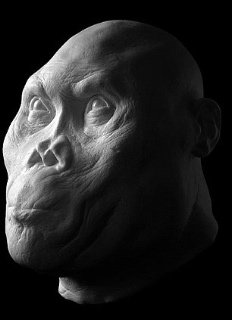
This species of sub-human – Homo rudolfensis – was found in Koobi Fora, Kenya, in 1972. The adult male is believed to have lived about 1.8 million years ago. He used stone axes, ate meat and plants and lived on the wooded edge of Lake Turkana in Eastern Africa.
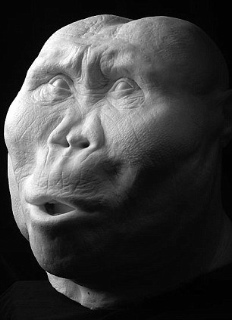
Researchers shaped this skull on the basis of this discovery of ‘Zinj’ in 1959 (Paranthropus or Australopithecus robustus). The adult male lived 1.8 million years ago in the Olduvai Gorge of Tanzania.
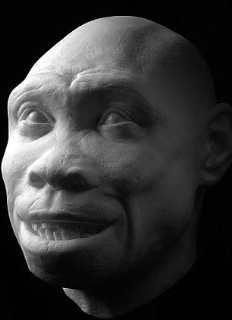
The near-complete skeleton of Turkana Boy, a male adolescent aged about 13, was found in Nariokotome, Kenya, in 1984. He lived 1.6 million years ago. His teeth and skull bear a close resemblance to discoveries in Asia of Homo erectus.

Discovered in Java, Indonesea, this skull belonging to ‘Sangiran 17’ is believed to have belonged to an adult male who probably lived around 800,000 years ago. Sangiran (Homo erectus) is believed to have used fire.
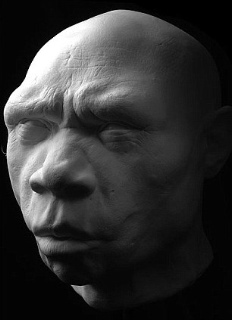
The discovery of this adult male in Sima de los Huesos, Spain, in 1993 points to an early stage in the evolution of Neandertal man (Homo neanderthalensis) due to the shape of his face. ‘Miquelon’ was around 1.75 m tall and lived about 500,000 to 350,000 years ago. His remains were found with that of 31 others, which led researchers to believe this was a burial site.
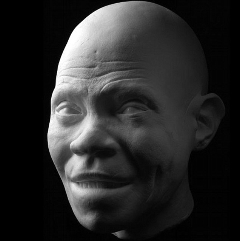
This young woman lived between 100,000 and 90,000 years ago. Her skull and mandible were found in a cave in Israel in 1969 along with the remains of 20 others. The size of their skulls was higher than that of the average person today.
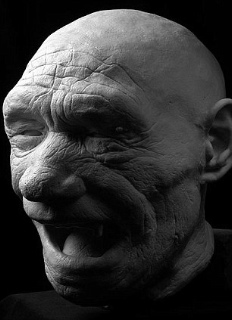
The Old man of La Chapelle was recreated from the skull and jaw of a male found near La Chapelle-aux-Saints, in France in 1908. He lived 56,000 years ago. His skeleton indicated he suffered a number of illness including arthritis and had numerous broken bones. This was not noticed when he was first discovered and gave rise to the mistaken belief that Neandertal man (Homo neanderthalensis) was a hunched individual. His relatively old age of between 40 to 50 indicates he was looked after by a clan.
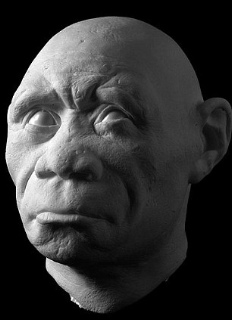
The skull and jaw of this female hobbit (Homo floresiensis) was found in Liang Bua, Flores, Indonesia, in 2003. She was about 1 meter tall and lived about 18,000 years ago. Later individuals were found dating as recently as 13,000 years before present. The discovery brought into question the belief that Homo sapiens was the only form of mankind for the past 30,000 years.
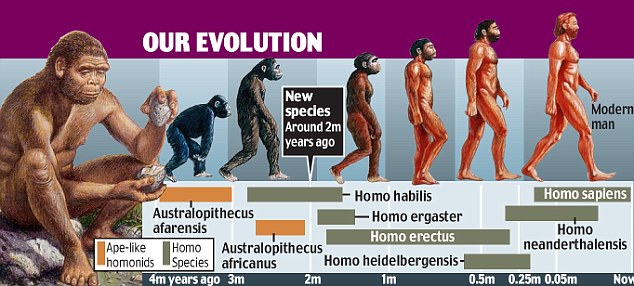
About Loren Coleman
Loren Coleman is one of the world’s leading cryptozoologists, some say “the” leading living cryptozoologist. Certainly, he is acknowledged as the current living American researcher and writer who has most popularized cryptozoology in the late 20th and early 21st centuries.
Starting his fieldwork and investigations in 1960, after traveling and trekking extensively in pursuit of cryptozoological mysteries, Coleman began writing to share his experiences in 1969. An honorary member of Ivan T. Sanderson’s Society for the Investigation of the Unexplained in the 1970s, Coleman has been bestowed with similar honorary memberships of the North Idaho College Cryptozoology Club in 1983, and in subsequent years, that of the British Columbia Scientific Cryptozoology Club, CryptoSafari International, and other international organizations. He was also a Life Member and Benefactor of the International Society of Cryptozoology (now-defunct).
Loren Coleman’s daily blog, as a member of the Cryptomundo Team, served as an ongoing avenue of communication for the ever-growing body of cryptozoo news from 2005 through 2013. He returned as an infrequent contributor beginning Halloween week of 2015.
Coleman is the founder in 2003, and current director of the International Cryptozoology Museum in Portland, Maine.
Filed under Almas, Breaking News, Cryptomundo Exclusive, CryptoZoo News, Evidence, Extinct, Forensic Science, Fossil Finds, Homo floresiensis, Media Appearances, New Species